Make black walnut tincture with the green hulls from black walnuts for its antifungal properties or as an external iodine supplement.
Many people think of black walnut trees as a nuisance. They drop their nuts with green hulls on driveways, roadways, and lawns. If they aren’t picked up immediately the green fruit rinds turn black and stain sidewalks and driveways. They leave behind a slippery mess that just gets worse in the freeze-thaw periods of fall.

Then there’s the nuts – a hard nut. Black walnuts defy cracking with ordinary measures. Only extraordinary techniques can release the delicious nut meats from their hard prison. It seems that few people today value the fruit of the black walnut tree. But I would like you to examine this treasure of nutrition and herbal medicine with fresh eyes.
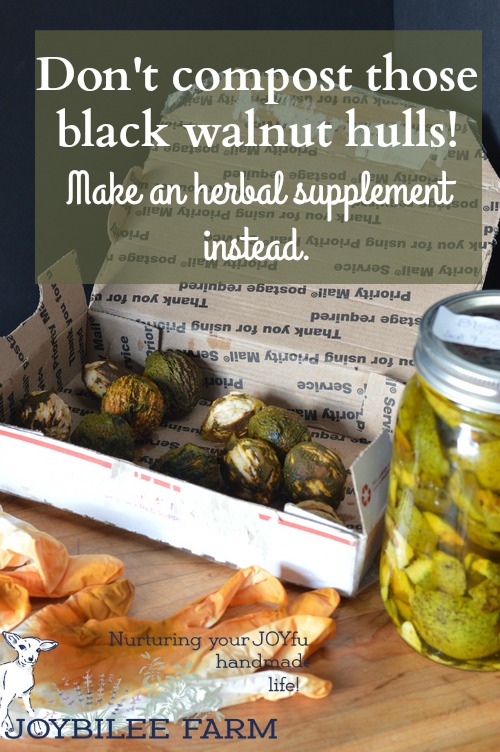
Recently I was given a box of 10 fresh, fleshy, still green black walnuts in their hulls. I was delighted because I have a single black walnut tree about 12 years old, and I wanted to add a few more black walnut trees to my permaculture garden. However living in BC, I wasn’t able to find any local black walnut trees to gather nuts for planting.
Planting black walnuts
The fruit of the black walnut tree has two parts – a fleshy hull that covers a hard nut in a shell. Using a knife I cut the fleshy, green hull from the nut. I set this hull aside to make an easy herbal tincture. The nuts need to be planted before they dry out to ensure good germination. I did a float test to check the nuts for viability. Out of the 10 black walnuts, 5 sunk to the bottom of the sink of warm water. These are the ones I used for planting.
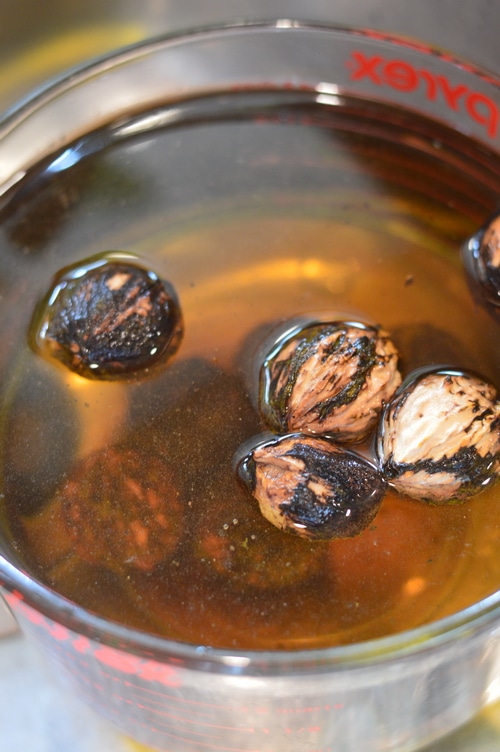
I planted the nuts in damp sand, in a planting pot and buried the pot in the garden, with a piece of hardware cloth over the top of the pots to discourage squirrels from digging up the nuts. I covered the hardware cloth with a few inches of dirt and marked the spot so that I could find it again in the spring. The nuts require a chill period before sprouting. They’ll get that over our long zone 3 winter – about 5 ½ months covered in snow.
In the spring I’ll wait for the nuts to germinate and then move the sprouted nuts to a new pot with soil.
Where to plant a black walnut tree
Black walnut trees exude juglans, a plant substance that prevents other plants from growing near a black walnut tree. If you plan to put a black walnut in your back garden you may be disappointed when you find that your asparagus, strawberries, and rhubarb struggle. However, there are a few plants that are unaffected by juglans. Here’s a list of 30 plants that are hardy in zone 3, that are good neighbors to black walnut.
How to make a black walnut tincture
The green hull is the part that herbalists are most interested in. It’s important when making a black walnut tincture to use the hulls before they turn black or become bruised. So choose walnuts that are a little under-ripe for best results.
I used the walnuts that I had which were about half fully ripe and half were under ripe. All the flesh was green with only a few flecks of brown. The hulls were about a ¼ inch thick and quite fleshy, with a strong iodine smell. You’ll recognize that smell when you cut into one. It smells just like the iodine that is sold for veterinary wound care.
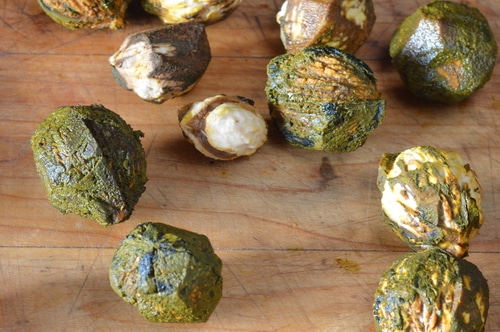
Black walnut hulls are a strong natural source of iodine. They are nourishing to the thyroid, especially where seaweed is hard to source. Take note of where you can find black walnut trees growing near you. This may be helpful, should you ever find yourself in need of iodine to protect from nuclear radiation, especially radioactive iodine, which can be absorbed by your thyroid in a situation where you are iodine deficient.
During the Chernobyl nuclear disaster, the areas in the fallout zone ran out of potassium iodide and seaweed sources of iodine. They used black walnut tincture as an iodine supplement by painting people’s knee skin with it. It was effective in preventing radiation poisoning of the thyroid in those treated with it. (That’s iodine on the glove). Walnut hulls are also a good source of vitamin C, which helps your body release toxins.
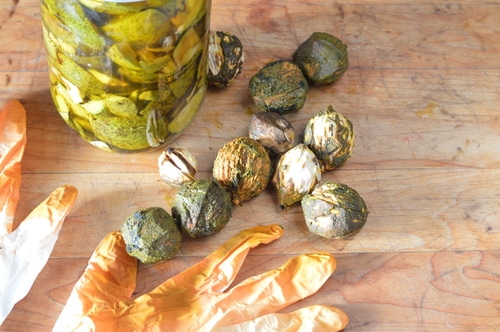
Black walnut hulls are antifungal and anti-parasitic, especially for intestinal parasites. They are also an antimicrobial, blood cleansing, detoxifying tonic. They have some sedative properties.
However, they are not an herbal supplement that should be taken daily. Black walnut hulls can be used externally to help with warts and herpes. To use it as an iodine supplement paint the tincture on the skin of the knees, rather than taking it internally.
It can be used as an antiviral, antifungal or to expel parasites when taken internally. However, because it is such a powerful supplement its use should be limited to no more than 2 weeks at a time.
Black Walnut Tincture recipe
Yield 5 – 100 ml bottles
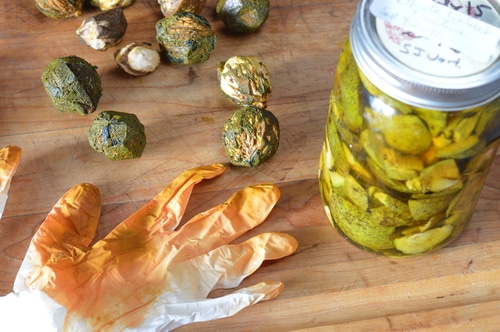
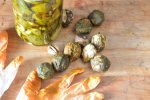
Black Walnut Tincture
Description
Use black walnut hulls for a locally sourced iodine tincture, use topically.
Ingredients
- 10 to 12 black walnut hulls
- 3 to 4 cups of 40% or higher proof vodka
- 1-quart jar
- 5 amber glass bottles with dropper lids
Instructions
- Fill a quart jar with fresh black walnut hulls. Pour 40% vodka over them. Generally, an herbalist would use an alcohol of at least 50% or 100 proof for this preparation, but where I live you can’t easily find vodka with a higher alcohol percentage. The tincture is still strong enough even with a lower alcohol percentage.
- Cap tightly. Label and date the jar. Shake the jar once a day or as often as you think of it. After 6 weeks, strain the jar contents, reserving the liquid. Press the spent walnut hulls with a potato ricer or other press, to capture as much of the tincture as possible. Discard the walnut hulls. Pour the completed tincture into amber glass bottles. Cap with a dropper lid.
- Label and date. The tincture will be good for years. Iodine is very stable.
Notes
The normal dosage of this tincture is very low since the herbal remedy is so strong. 15 drops can be taken in water, 3 times a day. To use it as an iodine supplement it’s just as effective to paint the skin with it as it is to take it orally.
Ingredients:
- 10 to 12 black walnut hulls
- 3 to 4 cups of 40% or higher proof vodka
- 1-quart jar
- 5 amber glass bottles with dropper lids
Method:
- Fill a quart jar with fresh black walnut hulls. Pour 40% vodka over them. Generally, an herbalist would use an alcohol of at least 50% or 100 proof for this preparation, but where I live you can’t easily find vodka with a higher alcohol percentage. The tincture is still strong enough even with a lower alcohol percentage.
- Cap tightly. Label and date the jar. Shake the jar once a day or as often as you think of it. After 6 weeks, strain the jar contents, reserving the liquid. Press the spent walnut hulls with a potato ricer or other press, to capture as much of the tincture as possible. Discard the walnut hulls. Pour the completed tincture into amber glass bottles. Cap with a dropper lid.
- Label and date. The tincture will be good for years. Iodine is very stable.
The normal dosage of this tincture is very low since the herbal remedy is so strong. 15 drops can be taken in water, 3 times a day. To use it as an iodine supplement it’s just as effective to paint the skin with it as it is to take it orally.
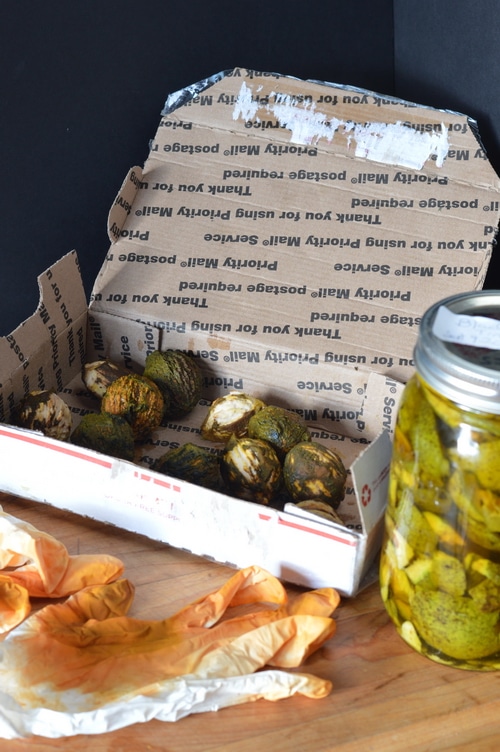
Standard herbal preparation
The tincture is 1:2 in 50% alcohol, the Usual supplement is 15 drops 3 to 4 times daily. (20 drops is equal to 1 ml).
Contraindications: It shouldn’t be used by those allergic to tree nuts, or by pregnant or nursing mothers.
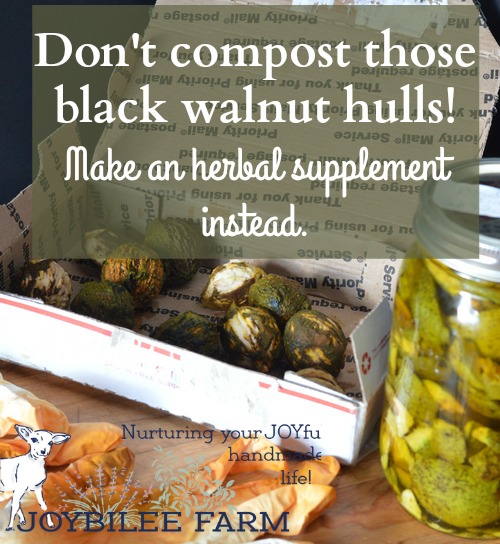
(Talk to your holistic health professional for personal recommendations — this is for information and educational purposes only.)
Other uses for black walnut include making natural dyes and homemade ink.



I made a pint–now to process nuts and make stain from the rest of the hulls.
However, I feel obligated to mention that I haven’t found a single non-anecdotal reference for black walnut ‘iodine’. I checked with my father–ex-biochemist and longtime biodiesel aficionado (also ex-cattle farmer, who learned about selenium deficiency symptoms the hard way). I checked the internet. I checked with Jim Duke, deceased author of The Green Pharmacy and the science behind the Peterson Field Guides’ Eastern/Central Medicinal Plants and Herbs, among others. I stuck my nose into my tincture, a bottle of vet povidone iodine, a fresh walnut hull, and a bottle of the stuff they sell for humans just for good measure. If you smell a similarity between veterinary iodine and black walnut tincture, it’s the alcohol. I checked the Alternative Advisor, and three other books.
The big reason I mention Dr. Duke is this–he dedicated most of his life to cross-referencing ethnobotany (folk medicine) with biochemical research (or at least trying to), SPECIFICALLY to challenge US big pharma and the bottlenecking of pharmacopeial research in the FDA. If there was a plant as well-known as black walnut available to answer common thyroid problems, he’d have been all over that.
In The Green Pharmacy, he mentions that a green walnut decoction showed promise in one study by raising Thyroxine levels 30+%–a hypothyroidism treatment, yes, but not related to iodine. Walnuts are used in Turkish folk medicine for endocrine disorders.
The blurbs in [Peterson] are organized to account for traditional ethnobotanical uses for different parts of a specific species, then talk about recent biochemical findings. While black walnut hulls are traditionally considered antifungal, antidiarrheal and sometimes anti-inflammatory, and extract is sold commercially as vermifuge, nowhere could I find any reference to iodine content. (Something I didn’t know is that the *leaves* are the bit with a lot of juglone–which recent research suggests is very sedative. That makes sense as even walnut saplings struggle under adult trees. You wouldn’t want to poison your own offspring anymore often than you can help, and prepackaging them in growth inhibitor would seem to do just that.)
The last word in the six books I checked is this: if you are in a region of iodine poor soils (and if you’re in British Colombia, the odds are good), don’t look to locally grown produce or animals for your iodine sources. That’s just not how iodine works. Try Kombu.
Hello,
What is the best way to ship the green hulls of black walnut so that they stay green?
Thank you.
It should be fine. As long as there aren’t any mold issues on the outside of the hulls you should be fine.
hi, I am a novice and I hulled the black walnuts but then chopped them up, so they definitely were not still green when I put them in the jar and added vodka. is that problem? did I just waste my time and my product?
Can I use the whole walnut, without breaking it down. I m traveling in upstate NJ . I live in upstate SC and there are no black walnut trees near me. I have the jars and plastic no leak lids and 100 proof vodka is available. Thank you for your response and for sharing your knowledge and experiences.